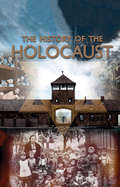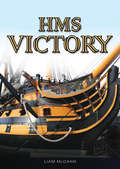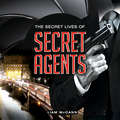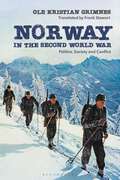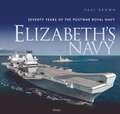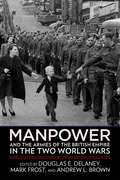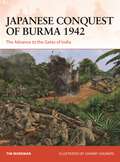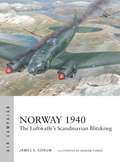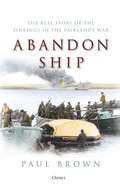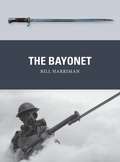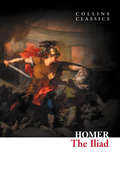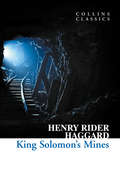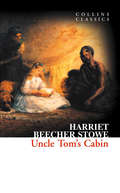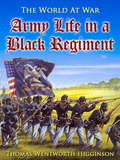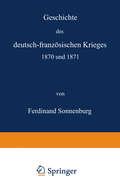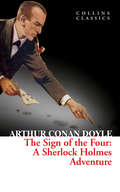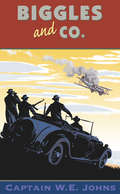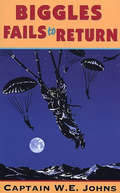- Table View
- List View
The History of the Holocaust
by Pat MorganFor 12 long years between 1933 until 1945, the inhuman Nazi regime in Germany waged a brutal, pitiless war on groups of people whom they considered inferior. Jews, Roma, Slavs, the disabled and homosexuals, as well as political opponents and religious enemies, were among the victims of what would become known as the Holocaust. Jews, whom the Nazis believed had been the authors of their country's downfall, were particular targets.At first through discrimination and persecution but later through violence, enslavement and mass murder, Hitler's henchmen and women carried out a merciless attempt to exterminate an entire people. Mobile squads of killers roamed eastern Europe seeking out their prey. Then, in a grisly attempt to industrialise the process of genocide, the Nazis opened up their death camps. Hundreds of thousands of men, women and children passed through the gates of camps such as Auschwitz-Birkenau and Treblinka. Hundreds of thousands never came out. The first of the death camps was liberated in 1944 and the unimaginable truth of the atrocities of the Holocaust began to emerge in 1945. But it was not until the 1960s that the scale and meaning of the years of murder began to be truly appreciated in the western world. Seventy years on from the liberation, it is time to reassess one of the most infamous episodes in mankind's history.
HMS Victory
by Liam McCannThe Royal Navy’s defining moment came at the Battle of Trafalgar in 1805. Thirty-three British ships under Admiral Horatio Nelson faced 41 ships of the combined French and Spanish navies off the southwest coast of Spain. Nelson shunned conventional naval tactics, which dictated lining your fleet up oppose the enemy and then pound them into submission. Instead, he divided his ships into two lines and drove them through the opposition at right angles in a manoeuvre known as crossing the T. It gave the French and Spanish an early advantage in that their ships could train all their portside guns at the Royal Navy but, as soon as their battle line had been crossed, Nelson opened up from both flanks and tore into the enemy fleet. The French and Spanish lost 22 ships and 14,000 men, while Nelson lost no ships and little more than 1,000 men. It was such a decisive engagement that it secured British naval supremacy until the middle of the 20th century. Nelson’s flagship at the battle was HMS Victory. This is her story written by acclaimed historian Liam McCann.
The Secret Lives of Secret Agents
by Liam McCannMany of us have grown up with James Bond, Jason Bourne and Jack Ryan as our heroes, but these spies live and work in a fictional world that bears little resemblance to reality. Secret agents have existed for as long as humans have been in conflict, and this book tells the stories of the people and agencies responsible for some of the most daring and disastrous exploits in the history of intelligence gathering, warfare and espionage. We’ll examine the lives of Nathan Hale, the man executed by the British during the American Revolutionary War; Sidney Reilly, Ace of Spies; and Aldrich Ames, the man who betrayed countless CIA officers and operations to the Soviet Union. We’ll also look at the lesser-known events surrounding the disappearance of Wilhelm Mörz, the only German spy thought to have escaped from Britain during the Second World War, and Mata Hari, the femme fatale who extracted secrets from both sides during World War One.The agencies behind these men and women will also be examined in detail, and no book on secret agents would be complete without paying tribute to the most famous spy on the silver screen: James Bond.
Norway in the Second World War: Politics, Society and Conflict
by Ole Kristian GrimnesCovering political, military, economic and social history, Norway in the Second World War is the most authoritative book on the subject in the English language. This innovative study describes how the Germans conquered Norway in 1940 and the type of government that was then imposed. German organisations such as the Wehrmacht, the SS and the civilian Reichskommissariat are all presented, along with how they operated during the occupation. Ole Kristian Grimnes examines the Norwegian Nazi Party and the important role that it played during the period, as well as analysing how the Norwegian economy became integrated into the German war economy. The Norwegian resistance (including the Communists) and the Norwegian government-in-exile are explored in detail, while a separate chapter on the Holocaust in both Norwegian and international contexts is also included. As such, Norway in the Second World War is the definitive text on war and Nazi occupation in a nation that has been sorely neglected by the literature in the field until now.
Elizabeth’s Navy: Seventy Years of the Postwar Royal Navy
by Paul BrownWith over 260 images, this is a highly illustrated history of the ships and operations of the Royal Navy during the reign of the late Queen Elizabeth II.During the 70 years spanned by the reign of the late Queen Elizabeth II, the Royal Navy changed out of all recognition. Its status as a superpower navy with worldwide bases and operations has been eclipsed, but it remains a powerful force because of its potency if not its size. Maritime history author Paul Brown takes us through each decade in turn, outlining the key events and developments, and charting the changes to the size, structure and capabilities of the Navy. Fully illustrated with over 260 colour and black and white images, this book also provides a stunning visual record of the ships and operations that featured most prominently in each decade.
Manpower and the Armies of the British Empire in the Two World Wars
by Douglas E. Delaney, Mark Frost, and Andrew L. BrownIn the first and only examination of how the British Empire and Commonwealth sustained its soldiers before, during, and after both world wars, a cast of leading military historians explores how the empire mobilized manpower to recruit workers, care for veterans, and transform factory workers and farmers into riflemen. Raising armies is more than counting people, putting them in uniform, and assigning them to formations. It demands efficient measures for recruitment, registration, and assignment. It requires processes for transforming common people into soldiers and then producing officers, staffs, and commanders to lead them. It necessitates balancing the needs of the armed services with industry and agriculture. And, often overlooked but illuminated incisively here, raising armies relies on medical services for mending wounded soldiers and programs and pensions to look after them when demobilized.Manpower and the Armies of the British Empire in the Two World Wars is a transnational look at how the empire did not always get these things right. But through trial, error, analysis, and introspection, it levied the large armies needed to prosecute both wars.Contributors Paul R. Bartrop, Charles Booth, Jean Bou, Daniel Byers, Kent Fedorowich, Jonathan Fennell, Meghan Fitzpatrick, Richard S. Grayson, Ian McGibbon, Jessica Meyer, Emma Newlands, Kaushik Roy, Roger Sarty, Gary Sheffield, Ian van der Waag
Japanese Conquest of Burma 1942: The Advance to the Gates of India (Campaign #384)
by Tim MoremanThis book provides a fascinating exploration of the Japanese conquest of Burma, as the Allied forces were forced back in disarray to India and China.The Japanese invasion of Burma in January 1942 marked the beginning of the single longest campaign of World War II. In the Burmese jungles, the battle-hardened, highly trained and lightly equipped Imperial Japanese Army quickly proved itself a vastly superior fighting force in clashes against the British, Indian and Gurkha troops that formed Burma Army and Chinese nationalist forces deployed in eastern Burma. This superbly illustrated book narrates Burma Corps' epic fighting retreat northwards, carried out mostly in contact with the enemy and across hundreds of miles of highly malarial and extremely difficult terrain, to safety in India. Among the battles covered are the disaster at the Sittang Bridge on 22 February 1942 (where 17th Indian Division was all but destroyed), the fall of Rangoon in March 1942 and the clashes at Yenangyaung, Monywa and Shwegyin. The performance of the opposing commanders and forces is also examined in detail, highlighting the success of Japanese aggressive light infantry tactics, which ruthlessly exploited the cover and concealment provided by the jungle to outflank, bypass and encircle their bewildered enemy.
Norway 1940: The Luftwaffe’s Scandinavian Blitzkrieg (Air Campaign #22)
by James S. CorumThe German invasion of Norway was a pivotal moment in modern warfare, the first joint campaign that featured air power as an equal element of all operations. It was, in fact, the superior use of their air force that gave the Germans the decisive margin of victory and ensured the failure of the Allied counter-offensive in central Norway in April and May 1940.All aspects of air power were employed in Norway, from long-range bombing and reconnaissance to air transport, with the Luftwaffe's ability to transport large numbers of troops and supply ground forces over great distances being particularly important. Norway was the first campaign in history in which key targets were seized by airborne forces, and the first in which air superiority was able to overcome the overwhelming naval superiority of an enemy.Researched from primary sources, this engaging history by air power expert Dr James Corum skilfully draws out where and why air power made the difference in Norway, and analyses the campaign's influence on the coming months and years of World War II.
Abandon Ship: The Real Story of the Sinkings in the Falklands War
by Paul BrownWhen Argentinian forces invaded the Falklands in April 1982, the British government responded by despatching a task force to the Atlantic to wrest back control of the islands. The resulting war saw modern weapon systems tested in combat for the first time, to tragic effect. In the aftermath, official documents were released, but many were heavily censored, and others withheld altogether, so that a full understanding of those events could not be gained. Drawing from recently declassified and previously unpublished reports from the official inquiry, Dr Paul Brown details the true story behind the dramatic events that led to the loss of six British ships – HMS Antelope, Ardent, Coventry and Sheffield, RFA Sir Galahad and SS Atlantic Conveyor – as well as the controversial sinking of the Argentinian cruiser ARA General Belgrano by HMS Conqueror.
The War in Italy: (WW2 #8) (The Ladybird Expert Series #14)
by James Holland* PRE-ORDER YOUR COPY NOW *- Why did the Allies decide to invade Southern Italy?- How did the weather and Italian terrain complicate the fighting?- How did General Mark Clark's Allied Armies win the final battle?Discover the mounting conflict and complex campaigns of the war in Italy. From Operation HUSKY to Clark's final offensive, the Allied campaign tightened the noose around Nazi Germany and saw the end of Italian Fascism, though it was at a cost of high civilian casualty and destruction.AN EPIC OF GRIT, DETERMINATION AND SACRIFICEWritten by historian, author and broadcaster James Holland and with immersive illustrations by Keith Burns, THE WAR IN ITALY 1943-1945 is an accessible and enthralling introduction to these critical battles and their impact on the outcome of World War II
The Bayonet (Weapon)
by Bill HarrimanAlthough muskets delivered devastating projectiles at comparatively long ranges, their slow rate of fire left the soldier very vulnerable while reloading, and early muskets were useless for close-quarter fighting. Consequently, European infantry regiments of the 17th century were composed of both musketeers and pikemen, who protected the musketeers while loading but also formed the shock component for close-quarter combat. The development of the flintlock musket produced a much less cumbersome and faster-firing firearm. When a short knife was stuck into its muzzle, every soldier could be armed with a missile weapon as well as one that could be used for close combat. The only disadvantage was that the musket could not be loaded or fired while the plug bayonet was in place. The socket bayonet solved this problem and the musket/bayonet combination became the universal infantry weapon from c.1700 to c.1870. The advent of shorter rifled firearms saw the attachment of short swords to rifle barrels. Their longer blades still gave the infantryman the 'reach' that contemporaries believed he needed to fend off cavalry attacks. The perfection of the small-bore magazine rifle in the 1890s saw the bayonet lose its tactical importance, becoming smaller and more knife-like, a trend that continued in the world wars. When assault rifles predominated from the 1950s onwards, the bayonet became a weapon of last resort. Its potential usefulness continued to be recognized, but its blade was often combined with an item with some additional function, most notably a wire-cutter. Ultimately, for all its fearsome reputation as a visceral, close-quarter fighting weapon, the bayonet's greatest impact was actually as a psychological weapon. Featuring full-colour artwork as well as archive and close-up photographs, this is the absorbing story of the complementary weapon to every soldier's firearm from the army of Louis XIV to modern-day forces in all global theatres of conflict.
Resolution: Two Brothers. A Nation in Crisis. A World at War
by David Rutland Emma EllisJohn Manners, Marquis of Granby, famously led a cavalry charge during the Seven Years War in 1760, losing both hat and wig. A commander of skill and courage, he was cherished by his men and lauded by the British public as an authentic military hero. Granby predeceased his father, the 3rd Duke of Rutland, and never inherited his title, but left two sons whose contrasting fortunes and tragically short lives are the subject of this meticulously researched and richly illustrated book. Charles became 4th Duke in 1779, sought reconciliation with the American colonies and was Viceroy of Ireland; Robert embarked on a naval career, became flag captain of the Resolution and died of injuries sustained at the Battle of the Saintes. Based upon the detailed archives held at Belvoir Castle, Resolution is both an enthralling saga of two generations of the Manners family and a finely delineated portrait of aristocratic, political and naval life in mid-Georgian England.
The Iliad: Edited With Apparatus Criticus, Prolegomena, Notes And Appendices: Vol I. , Books I-xii (Collins Classics)
by HomerHarperCollins is proud to present its new range of best-loved, essential classics.
King Solomon’s Mines (Collins Classics)
by Henry Rider HaggardHarperCollins is proud to present a range of best-loved, essential classics.
Shirley (Collins Classics)
by Charlotte BrontëHarperCollins is proud to present its new range of best-loved, essential classics.
Uncle Tom’s Cabin: Or Life Among The Lowly (1899) (Collins Classics)
by Harriet Beecher StoweHarperCollins is proud to present its new range of best-loved, essential classics.
Der Antagonismus Frankreichs und Englands vom politisch-militairischen Standpunkte und die Wahrscheinlichkeit einer französischen Truppenlandang auf der englischen Südküste
by Gerhardt GerhardtArmy Life in a Black Regiment (The World At War)
by Thomas Wentworth HigginsonThomas Wentworth Higginson (December 22, 1823 – May 9, 1911) was an American Unitarian minister, author, abolitionist, and soldier. He was active in the American Abolitionism movement during the 1840s and 1850s, identifying himself with disunion and militant abolitionism. He was a member of the Secret Six who supported John Brown. During the Civil War, he served as colonel of the 1st South Carolina Volunteers, the first federally authorised black regiment, from 1862–1864. Following the war, Higginson devoted much of the rest of his life to fighting for the rights of freed slaves, women and other disfranchised peoples. (Excerpt from Wikipedia)
The Sign of the Four: Second Of The Four Sherlock Holmes Novels (Collins Classics)
by Arthur Conan DoyleHarperCollins is proud to present its incredible range of best-loved, essential classics.
Biggles and Co (Biggles #10)
by W E Johns'Now Listen, Bigglesworth; I'll tell you what I'm prepared to do, and you can please yourself what you do about it. Run this gang of crooks to earth, or point out to me the man that is at the head of it - or the chief operator in this country - and I'll make you a present of a cheque for ten thousand pounds.'Colonel Raymond from Intelligence persuades Biggles, Algy and Ginger to take on the challenge of transporting gold bullion and diamonds to France. Every other firm which has taken the job has failed and the gold has been stolen, the planes crashed or disappeared and the pilots have lost their lives. Biggles comes up with daring scheme after daring scheme, but then Algy is captured and held to ransom and Biggles finds that he's up against his old enemy - Von Stalhein
Biggles Fails to Return (Biggles #14)
by W E Johns'It is my opinion that Biggles is dead,' asserted the Air Commodore.'I had already sensed that, Sir, but I don't believe it,' retorted Algy.When Biggles undertakes a lone mission to rescue an Italian princess from Mussolini's Italy he doesn't know he's walking into a trap. Against all the odds he gets the princess to the aircraft ready to fly them back to safety, but he never reaches the plane. He's last seen wounded and surrounded by the enemy, but Algy, Ginger and Bertie refuse to accept that he's dead until they see the evidence themselves.
